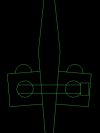- Joined
- Dec 3, 1999
- Messages
- 9,437
Deloid- I don't disagree at all.  Actually reading my own words in your post made me cringe a little, as it sounds like I'm trying to remove the human element from my work... Which I'm not! I spend much more time at my handwork benches than anywhere else in the shop, and every once-in-a-great-while will build a small simple knife with only hand tools just for my own gratification...
Actually reading my own words in your post made me cringe a little, as it sounds like I'm trying to remove the human element from my work... Which I'm not! I spend much more time at my handwork benches than anywhere else in the shop, and every once-in-a-great-while will build a small simple knife with only hand tools just for my own gratification...
But just as stevomiller mentioned, there's a certain amount of efficiency that I have to have to keep doing this stuff for a living... and I'd rather spend the "hand time" on sculpting the handle shape with files and sandpaper than spending that time filing the shoulders without a jig.

So certainly no disagreement on my part.
Eric, I actually have pencil sketches of that same fixture, from my very first class with Mike! My only hangup with this style is getting the blade in there exactly how I want it. I think a fixture like that, with guide pins to make sure the clamping piece comes down square would be pretty foolproof.
My only hangup with this style is getting the blade in there exactly how I want it. I think a fixture like that, with guide pins to make sure the clamping piece comes down square would be pretty foolproof.
Thanks guys
But just as stevomiller mentioned, there's a certain amount of efficiency that I have to have to keep doing this stuff for a living... and I'd rather spend the "hand time" on sculpting the handle shape with files and sandpaper than spending that time filing the shoulders without a jig.
So certainly no disagreement on my part.
Eric, I actually have pencil sketches of that same fixture, from my very first class with Mike!
Thanks guys


